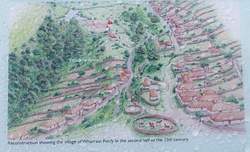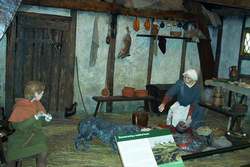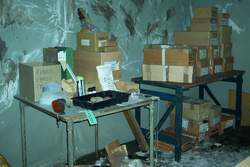Abandoned Communities ..... Wharram Percy
There are no contemporary documents describing the abandonment of Wharram Percy, but it is likely that it suffered the same fate as very many other small communities at the end of the medieval period. For a century and a half the rural economy of England had been undergoing profound changes. The traditional feudal system was overturned. Rather than seeing themselves confined to one place throughout their lives people were more ready to move in search of opportunities to improve their lifestyle. The great plague of 1348 caused massive loss of life and general devastation, but it had the effect of making the labour of an individual worker more valuable. Landowners were obliged to pay higher wages or accept lower rents. Landowners themselves became more inclined to look for ways of making their property more profitable. In many places they realised that the farming of sheep could yield greater profits than continuing to concentrate on grain production. Large areas were enclosed, and the tenants, now regarded as redundant, were evicted.
For a general account of the medieval enclosure of open land and its conversion into pasture I would recommend chapter 6 in Richard Muir, The Lost Villages of Britain, M Joseph, 1982.
As mentioned earlier, by the end of the fifteenth century Parliament was starting to take action to curb the rapid trend towards enclosure. Many writers condemned the social changes caused by the development of sheep farms. In 1549, for example, Bishop Latimer complained that “where there have been a great many householders and inhabitants there is now but a shepherd and his dog”.
Latimer, Sermons, p 85 in the modern edition published by Everyman.
The most renowned critic of enclosure was Thomas More. In Utopia More blamed sheep for stealing and many other social evils. The relevant section begins “The increase of pasture, by which your sheep, which are naturally mild and easily kept in order, may be said now to devour men, and unpeople, not only villages, but towns; for wherever it is found that the sheep of any soil yield a softer and richer wool than ordinary, there the nobility and gentry, and even those holy men the abbots, not contented with the old rents which their farms yielded, nor thinking it enough that they, living at their ease, do no good to the public, resolve to do it hurt instead of good”.
The whole of Book One of Utopia can be read at this address. The section on sheep can be found about one tenth of the way through the document but you may reach it more quickly by using the “Find” facility and entering the word sheep.
We know that the last inhabitants left Wharram Percy around 1500. They were evicted. Before that date it is possible that others had already been evicted, but also likely that some people had been departing in a voluntary manner. If it is true that the village and its fields were converted into pasture we do not know whether the enclosure took place in gradual stages or was carried out in a single large scale action.
Today the site of Wharram Percy is still privately owned, but it is managed by Historic England and open to the public. If you wish you can follow a series of excellent information panels. They will take you from either the north or the south site entrance to the eighteenth century improvement farm, the church yard, St Martin’s church, the dam and fishpond, a group of longhouses, the south manor, and the north manor.
For a general account of the medieval enclosure of open land and its conversion into pasture I would recommend chapter 6 in Richard Muir, The Lost Villages of Britain, M Joseph, 1982.
As mentioned earlier, by the end of the fifteenth century Parliament was starting to take action to curb the rapid trend towards enclosure. Many writers condemned the social changes caused by the development of sheep farms. In 1549, for example, Bishop Latimer complained that “where there have been a great many householders and inhabitants there is now but a shepherd and his dog”.
Latimer, Sermons, p 85 in the modern edition published by Everyman.
The most renowned critic of enclosure was Thomas More. In Utopia More blamed sheep for stealing and many other social evils. The relevant section begins “The increase of pasture, by which your sheep, which are naturally mild and easily kept in order, may be said now to devour men, and unpeople, not only villages, but towns; for wherever it is found that the sheep of any soil yield a softer and richer wool than ordinary, there the nobility and gentry, and even those holy men the abbots, not contented with the old rents which their farms yielded, nor thinking it enough that they, living at their ease, do no good to the public, resolve to do it hurt instead of good”.
The whole of Book One of Utopia can be read at this address. The section on sheep can be found about one tenth of the way through the document but you may reach it more quickly by using the “Find” facility and entering the word sheep.
We know that the last inhabitants left Wharram Percy around 1500. They were evicted. Before that date it is possible that others had already been evicted, but also likely that some people had been departing in a voluntary manner. If it is true that the village and its fields were converted into pasture we do not know whether the enclosure took place in gradual stages or was carried out in a single large scale action.
Today the site of Wharram Percy is still privately owned, but it is managed by Historic England and open to the public. If you wish you can follow a series of excellent information panels. They will take you from either the north or the south site entrance to the eighteenth century improvement farm, the church yard, St Martin’s church, the dam and fishpond, a group of longhouses, the south manor, and the north manor.
Six
One of the information panels at Wharram Percy (with apologies for the raindrops)
Replica of part of the finds tent used by the archaeologists
Replica of the living room of a longhouse
These two photographs were taken at Malton Museum in June 2006


